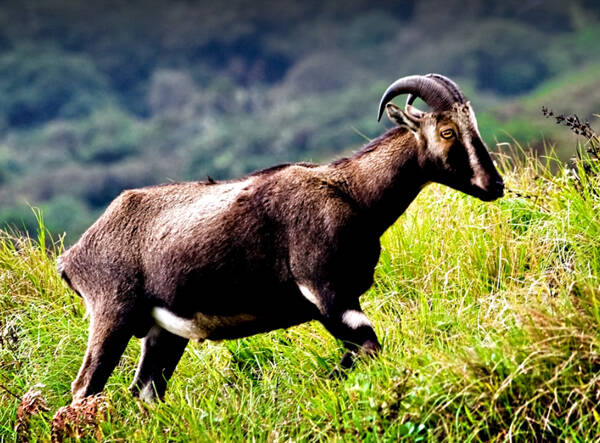Nilgiritragus hylocrius
IUCN
LCBasic Information
Scientific classification
- name:Nilgiritragus hylocrius
- Scientific Name:Nilgiritragus hylocrius,Nilgiri Tahr
- Outline:Ungulata
- Family:Artiodactyla Bovidae Nilgiri-Tahr
Vital signs
- length:110-150cm
- Weight:50-100kg
- lifetime:9+ years
Feature
Both sexes are beardless and have a silver "saddle" on their backs and white patches on their front legs.
Distribution and Habitat
The Nilgiri Taar's distribution is restricted to the Western Ghats of southern India, Kerala, and about 5% of the southern Indian state of Tamil Nadu, not along the border between the two states. In the early 20th century, the Nilgiri Taar's range probably extended at least as far north as the Brahmagiri hills in southern Karnataka.
The Nilgiri Taar is endemic to the Western Ghats of southern India. They are usually found in grasslands, grassy hills, and open areas near cliff faces at altitudes of 1,200-2,600 m, avoiding low-altitude forests.
Appearance
The Nilgiri Tahr is a sexually dimorphic species, with males weighing 50 kg and 80-100 kg respectively. Individuals and young adult females are yellowish brown overall, with lighter underparts; a dark stripe runs along the midline of the back. As males age (starting around 2 years of age and continuing until full maturity at age 6+), their fur darkens to a dark dark brown. At the same time, several bright markings appear, including a silvery "saddle" on the back and white patches on the forelegs. While the head of an adult female is the same color as the body, the face of an adult male darkens to nearly black, with a pair of silvery stripes running from the base of the horns to the muzzle. Neither sex is bearded. Both sexes have fairly short, curved horns with a faint ridge on the front surface; male horns can reach 44.5 cm in length, while females tend to be shorter, usually only 30 cm, and are less massive.
Details
The Nilgiri Tahr sheep (scientific name: Nilgiritragus hylocrius) has a foreign name of Nilgiri Tahr and has no subspecies.

Nilgiri Tahr sheep are diurnal but most active in the early morning and evening. At noon, the sheep often retreat to the shade of the cliffs. These cliffs also serve as refuge when they are threatened by predators. At least one member of the pack (usually an adult female) acts as a sentinel, sounding an alarm whistle or snorting if danger is detected. Females typically remain within specific home ranges, while adult males form loose groups and will move between groups of females, occasionally joining all-male groups or remaining solitary. Conspicuous markings by males aid in the development of dominance hierarchies, allowing competitors to assess their relative status. Evenly matched males compete for position by standing side by side and bumping into each other or head-on.
Nilgiri Tahr sheep are usually found in mixed groups or single-sex groups, with 11-71 animals in each group. Adult males may be solitary, especially during India's hot season (March to May). Feeds on grasses and herbs.
The Nilgiri Tahr breeds throughout the year, but breeding behavior increases during the monsoon period from June to August. The gestation period is 178-190 days. The litter size is 1, rarely 2. The weaning period for young sheep is 4-6 months. The lambs do not immediately follow their mother, but "hide" in hiding places while the mother is away foraging for up to two months. Young lambs may start trying solid foods as early as two weeks old. Females reach sexual maturity as early as 16 months, and males usually do not reach full maturity until 6-8 years old. Lifespan in the wild is at least 9 years.

During the 1970s and 1980s, the total Nilgiri Tahr sheep population was estimated to be between 2,000 and 2,500, and was considered stable. In 2008, Daniels and others estimated the total population at no more than 1,800-2,000 individuals, and although some populations appeared to remain stable over several decades, the species' numbers were declining overall. As of 2008, the species population was estimated to be Nilgiri Hills (450 individuals, but reduced to 75-100 individuals), Silent Valley (30 individuals), Siruveni Hills (20 individuals), Elival Mala (60 individuals), Nelliampathi Hills (30 individuals), Top Slip and Parambikulam (120 birds), Anamala Eastern Slope (125 birds), Anamala Grass Mountain (250 birds), Swamai Mara (130 birds) Eravikulam National Park (760 birds) , High Range (30 birds), Palani mountains (60 birds), Highwavy mountains (100 birds), Ashambu Hills (70 birds), Vellakaltheri (90 birds), Ashambu Hills (70 birds) and Thiruvannamalai peak (40 birds) (Nilgiri Tahr Trust, retrieved January 2, 2007).
The Nilgiri Tahr sheep population is small and isolated, making it vulnerable to local extinction. The species' active patches are discontinuous in nature, but some habitat fragmentation may have anthropogenic causes. The species faces competition from domestic livestock, and its overgrazing has led to the invasion of grazing-resistant weed species into preferred grasslands, thereby competing with the native grasses preferred by the Nilgiri Tahr sheep. Humans continue to convert the Nilgiri Tahr's habitat to agricultural land, resulting in the species' distribution range being approximately one-tenth of its historical range (Mishra and Johnsingh, 1998 Kannery, 2002; IUCN, 2004) .
Listed in the "World Conservation Union Red List of Threatened Species" (IUCN) 2008 ver3.1 - Endangered (EN).
Protect wild animals and eliminate wild game.
Maintaining ecological balance is everyone’s responsibility!








